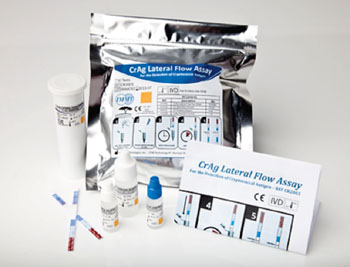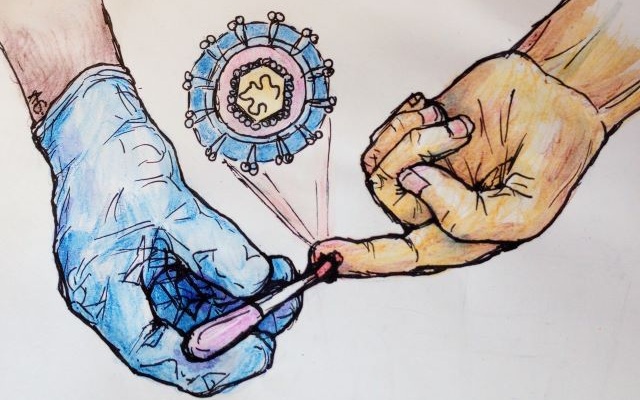Lateral Flow Immunoassay Validated for Detection of Cryptococcal Antigen
|
By LabMedica International staff writers Posted on 23 Feb 2015 |

Image: The CrAg lateral flow assay to detect cryptococcal antigens (Photo courtesy of Immuno-Mycologics).
Cryptococcosis is an important and potentially lethal opportunistic infection in immunocompromised patients, especially in human immunodeficiency virus (HIV) infected and organ transplant patients.
The incidence of the infection in non-HIV immunocompromised patients caused by Cryptococcus neoformans and in immunocompetent patients caused by C. gattii has increased in developed countries.
Medical microbiologists at the Johns Hopkins University School of Medicine (Baltimore, MD, USA) compared a lateral flow immunoassay (LFA) to a currently used enzyme immunoassay for detection of cryptococcal antigen in 396 sera and 651 cerebrospinal fluid specimens. The cryptococcal antigen detection was performed in retrospective and prospective sera and CSF specimens collected from March 2010 to August 2012 in patients suspected of cryptococcal infection from the Johns Hopkins Hospital, an academic tertiary care hospital.
The newly developed CrAg lateral flow immunoassay (LFA) (Immuno-Mycologics [IMMY]; Norman, OK, USA) offers a rapid and easy alternative detection platform. The LFA assay detects glucuronoxylomannan (GXM), the major polysaccharide component of the cryptococcal capsule. It is a dipstick sandwich immunochromatographic assay that captures the GXM by gold-conjugated anti-Cryptococcus monoclonal antibodies incorporated on the dipstick membrane. This test was compared with an enzyme immunoassay (EIA) from Meridian Premier (Meridian Biosciences; Cincinnati, OH, USA).
The scientists found 97% concordance between the two assays. The LFA assay detected an additional 22 positives. Overall, the LFA had sensitivity of 100% and specificity of 99.6% for the diagnosis of cryptococcosis. Although reading the LFA result can be subjective, they found that the visible lines suggestive of positive results are usually easy to determine. Easy readability combined with additional advantages of rapid turn-around time of 10-minutes ease of performance, requiring little technical expertise, and limited cost make the LFA an attractive tool for routine laboratory use.
The authors concluded that the IMMY LFA showed better sensitivity in detecting C. neoformans antigen in serum and CSF specimens compared to an EIA method in current use. Because of the enhanced sensitivity, users must be aware of the possibility of false positive results in patients with low clinical suspicion of cryptococcal infection. The LFA is rapid, accurate, easy to perform, and cost-effective, and thus it is attractive for implementation by clinical laboratories for routine patient care testing. The study was published on January 31, 2015, in the journal Diagnostic Microbiology and Infectious Disease.
Related Links:
Johns Hopkins University School of Medicine
Immuno-Mycologics
Meridian Biosciences
The incidence of the infection in non-HIV immunocompromised patients caused by Cryptococcus neoformans and in immunocompetent patients caused by C. gattii has increased in developed countries.
Medical microbiologists at the Johns Hopkins University School of Medicine (Baltimore, MD, USA) compared a lateral flow immunoassay (LFA) to a currently used enzyme immunoassay for detection of cryptococcal antigen in 396 sera and 651 cerebrospinal fluid specimens. The cryptococcal antigen detection was performed in retrospective and prospective sera and CSF specimens collected from March 2010 to August 2012 in patients suspected of cryptococcal infection from the Johns Hopkins Hospital, an academic tertiary care hospital.
The newly developed CrAg lateral flow immunoassay (LFA) (Immuno-Mycologics [IMMY]; Norman, OK, USA) offers a rapid and easy alternative detection platform. The LFA assay detects glucuronoxylomannan (GXM), the major polysaccharide component of the cryptococcal capsule. It is a dipstick sandwich immunochromatographic assay that captures the GXM by gold-conjugated anti-Cryptococcus monoclonal antibodies incorporated on the dipstick membrane. This test was compared with an enzyme immunoassay (EIA) from Meridian Premier (Meridian Biosciences; Cincinnati, OH, USA).
The scientists found 97% concordance between the two assays. The LFA assay detected an additional 22 positives. Overall, the LFA had sensitivity of 100% and specificity of 99.6% for the diagnosis of cryptococcosis. Although reading the LFA result can be subjective, they found that the visible lines suggestive of positive results are usually easy to determine. Easy readability combined with additional advantages of rapid turn-around time of 10-minutes ease of performance, requiring little technical expertise, and limited cost make the LFA an attractive tool for routine laboratory use.
The authors concluded that the IMMY LFA showed better sensitivity in detecting C. neoformans antigen in serum and CSF specimens compared to an EIA method in current use. Because of the enhanced sensitivity, users must be aware of the possibility of false positive results in patients with low clinical suspicion of cryptococcal infection. The LFA is rapid, accurate, easy to perform, and cost-effective, and thus it is attractive for implementation by clinical laboratories for routine patient care testing. The study was published on January 31, 2015, in the journal Diagnostic Microbiology and Infectious Disease.
Related Links:
Johns Hopkins University School of Medicine
Immuno-Mycologics
Meridian Biosciences
Latest Microbiology News
- New UTI Diagnosis Method Delivers Antibiotic Resistance Results 24 Hours Earlier
- Breakthroughs in Microbial Analysis to Enhance Disease Prediction
- Blood-Based Diagnostic Method Could Identify Pediatric LRTIs
- Rapid Diagnostic Test Matches Gold Standard for Sepsis Detection
- Rapid POC Tuberculosis Test Provides Results Within 15 Minutes
- Rapid Assay Identifies Bloodstream Infection Pathogens Directly from Patient Samples
- Blood-Based Molecular Signatures to Enable Rapid EPTB Diagnosis
- 15-Minute Blood Test Diagnoses Life-Threatening Infections in Children
- High-Throughput Enteric Panels Detect Multiple GI Bacterial Infections from Single Stool Swab Sample
- Fast Noninvasive Bedside Test Uses Sugar Fingerprint to Detect Fungal Infections
- Rapid Sepsis Diagnostic Device to Enable Personalized Critical Care for ICU Patients
- Microfluidic Platform Assesses Neutrophil Function in Sepsis Patients
- New Diagnostic Method Confirms Sepsis Infections Earlier
- New Markers Could Predict Risk of Severe Chlamydia Infection
- Portable Spectroscopy Rapidly and Noninvasively Detects Bacterial Species in Vaginal Fluid
- CRISPR-Based Saliva Test Detects Tuberculosis Directly from Sputum
Channels
Clinical Chemistry
view channel
Blood Test Could Predict and Identify Early Relapses in Myeloma Patients
Multiple myeloma is an incurable cancer of the bone marrow, and while many patients now live for more than a decade after diagnosis, a significant proportion relapse much earlier with poor outcomes.... Read more
Compact Raman Imaging System Detects Subtle Tumor Signals
Accurate cancer diagnosis often depends on labor-intensive tissue staining and expert pathological review, which can delay results and limit access to rapid screening. These conventional methods also make... Read moreMolecular Diagnostics
view channel
Ultra-Sensitive Blood Biomarkers Enable Population-Scale Insights into Alzheimer’s Pathology
Accurately estimating how many people carry Alzheimer’s disease pathology has long been a challenge, as traditional methods rely on small, clinic-based samples rather than the general population.... Read more
Blood Test Could Predict Death Risk in World’s Most Common Inherited Heart Disease
Hypertrophic cardiomyopathy (HCM) is the world’s most common inherited heart condition and affects millions of people globally. While some patients live with few or no symptoms, others develop heart failure,... Read moreHematology
view channel
MRD Tests Could Predict Survival in Leukemia Patients
Acute myeloid leukemia is an aggressive blood cancer that disrupts normal blood cell production and often relapses even after intensive treatment. Clinicians currently lack early, reliable markers to predict... Read more
Platelet Activity Blood Test in Middle Age Could Identify Early Alzheimer’s Risk
Early detection of Alzheimer’s disease remains one of the biggest unmet needs in neurology, particularly because the biological changes underlying the disorder begin decades before memory symptoms appear.... Read more
Microvesicles Measurement Could Detect Vascular Injury in Sickle Cell Disease Patients
Assessing disease severity in sickle cell disease (SCD) remains challenging, especially when trying to predict hemolysis, vascular injury, and risk of complications such as vaso-occlusive crises.... Read more
ADLM’s New Coagulation Testing Guidance to Improve Care for Patients on Blood Thinners
Direct oral anticoagulants (DOACs) are one of the most common types of blood thinners. Patients take them to prevent a host of complications that could arise from blood clotting, including stroke, deep... Read moreImmunology
view channel
Ultrasensitive Liquid Biopsy Demonstrates Efficacy in Predicting Immunotherapy Response
Immunotherapy has transformed cancer treatment, but only a small proportion of patients experience lasting benefit, with response rates often remaining between 10% and 20%. Clinicians currently lack reliable... Read more
Blood Test Could Identify Colon Cancer Patients to Benefit from NSAIDs
Colon cancer remains a major cause of cancer-related illness, with many patients facing relapse even after surgery and chemotherapy. Up to 40% of people with stage III disease experience recurrence, highlighting... Read morePathology
view channel
Genetics and AI Improve Diagnosis of Aortic Stenosis
Aortic stenosis is a progressive narrowing of the aortic valve that restricts blood flow from the heart and can be fatal if left untreated. There are currently no medical therapies that can prevent or... Read more
AI Tool Simultaneously Identifies Genetic Mutations and Disease Type
Interpreting genetic test results remains a major challenge in modern medicine, particularly for rare and complex diseases. While existing tools can indicate whether a genetic mutation is harmful, they... Read more
Rapid Low-Cost Tests Can Prevent Child Deaths from Contaminated Medicinal Syrups
Medicinal syrups contaminated with toxic chemicals have caused the deaths of hundreds of children worldwide, exposing a critical gap in how these products are tested before reaching patients.... Read more
Tumor Signals in Saliva and Blood Enable Non-Invasive Monitoring of Head and Neck Cancer
Head and neck cancers are among the most aggressive malignancies worldwide, with nearly 900,000 new cases diagnosed each year. Monitoring these cancers for recurrence or relapse typically relies on tissue... Read moreTechnology
view channel
Pioneering Blood Test Detects Lung Cancer Using Infrared Imaging
Detecting cancer early and tracking how it responds to treatment remains a major challenge, particularly when cancer cells are present in extremely low numbers in the bloodstream. Circulating tumor cells... Read more
AI Predicts Colorectal Cancer Survival Using Clinical and Molecular Features
Colorectal cancer is one of the most common and deadly cancers worldwide, and accurately predicting patient survival remains a major clinical challenge. Traditional prognostic tools often rely on either... Read moreIndustry
view channel
BD and Penn Institute Collaborate to Advance Immunotherapy through Flow Cytometry
BD (Becton, Dickinson and Company, Franklin Lakes, NJ, USA) has entered into a strategic collaboration with the Institute for Immunology and Immune Health (I3H, Philadelphia, PA, USA) at the University... Read more









 Analyzer.jpg)









